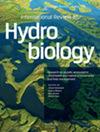Across-shore differences in lake benthic invertebrate communities within reed stands (Phragmites australis (Cav.) Trin. ex Steud.)
Abstract
The spatial distribution of benthic macroinvertebrates along reed transects was studied in lakes with minimal human disturbances to enable a deeper understanding of the functioning of reed macroinvertebrate communities and relations to biotic and abiotic environmental variables. The taxonomic and functional macroinvertebrate community composition significantly differed between outer margin, center, and shore locations. At shore locations, higher proportions of Gastropoda, Hydrachnidia and Coleoptera, mobile swimmers/skaters, predators, and shredders were found. However, outer margin locations were characterized by a higher proportion of sessile filter-feeding Bivalvia and mining Diptera. At the outer margins, also greater contributions of taxa preferring pelal habitats and r-strategists typical for more disturbed environments were observed. An indicator species analysis revealed Asellus aquaticus (Crustacea) and Scirtidae Gen sp. (Coleoptera) as significant indicator taxa for shore locations and Valvata piscinalis (Gastropoda), Tinodes sp. and Orthotrichia sp. (Trichoptera) as significant indicator taxa for outer margin locations. The taxonomic composition of macroinvertebrate communities was significantly related to higher water depth, oxygen content, and pH at outer margin locations. Shore locations were characterized by higher amounts of woody debris, leaf litter, and decaying plant material. In summary, the taxonomic and functional composition of macroinvertebrates varied strongly from shore to outer margin locations and could be related to spatial changes in hydrodynamical and food conditions along the transects.

 求助内容:
求助内容: 应助结果提醒方式:
应助结果提醒方式:


